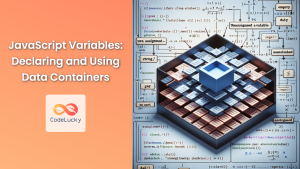Are you ready to put your JavaScript skills to the test? 🧠💻 Whether you're a seasoned developer or just starting your coding journey, this comprehensive JavaScript quiz will challenge your understanding of core concepts, syntax, and best practices. Let's dive in and see how well you know the world's most popular programming language!
Question 1: Variable Declarations
Which of the following is not a valid way to declare a variable in JavaScript?
a) var x = 5;
b) let y = 10;
c) const z = 15;
d) variable w = 20;
Answer: d) variable w = 20;
Explanation: JavaScript provides three ways to declare variables: var, let, and const. The keyword variable is not a valid declaration in JavaScript.
Let's explore each valid declaration:
// Using var (function-scoped or globally-scoped)
var x = 5;
console.log(x); // Output: 5
// Using let (block-scoped)
let y = 10;
console.log(y); // Output: 10
// Using const (block-scoped, cannot be reassigned)
const z = 15;
console.log(z); // Output: 15
// Trying to use 'variable' will result in an error
variable w = 20; // Uncaught SyntaxError: Unexpected identifier
It's important to note that var is the oldest way to declare variables and has some quirks related to hoisting and scope. Modern JavaScript encourages the use of let and const for better code organization and fewer unexpected behaviors.
Question 2: Function Declarations
Which of the following is not a valid way to declare a function in JavaScript?
a) function myFunction() {}
b) const myFunction = function() {}
c) const myFunction = () => {}
d) function = myFunction() {}
Answer: d) function = myFunction() {}
Explanation: JavaScript offers multiple ways to declare functions, but option d is not a valid syntax. Let's examine each option:
// a) Function declaration
function myFunction1() {
console.log("This is a function declaration");
}
myFunction1(); // Output: This is a function declaration
// b) Function expression
const myFunction2 = function() {
console.log("This is a function expression");
};
myFunction2(); // Output: This is a function expression
// c) Arrow function
const myFunction3 = () => {
console.log("This is an arrow function");
};
myFunction3(); // Output: This is an arrow function
// d) Invalid syntax
function = myFunction4() {} // SyntaxError: Unexpected token '='
Each valid function declaration has its use cases and slight differences in behavior, especially regarding this binding and hoisting.
Question 3: Array Methods
Which array method is used to add one or more elements to the end of an array and returns the new length of the array?
a) push()
b) pop()
c) shift()
d) unshift()
Answer: a) push()
Explanation: The push() method adds one or more elements to the end of an array and returns the new length of the array. Let's look at how each of these methods works:
let fruits = ['apple', 'banana'];
// push(): Adds elements to the end
let newLength = fruits.push('orange', 'mango');
console.log(fruits); // Output: ['apple', 'banana', 'orange', 'mango']
console.log(newLength); // Output: 4
// pop(): Removes the last element
let lastFruit = fruits.pop();
console.log(fruits); // Output: ['apple', 'banana', 'orange']
console.log(lastFruit); // Output: 'mango'
// shift(): Removes the first element
let firstFruit = fruits.shift();
console.log(fruits); // Output: ['banana', 'orange']
console.log(firstFruit); // Output: 'apple'
// unshift(): Adds elements to the beginning
newLength = fruits.unshift('grape', 'kiwi');
console.log(fruits); // Output: ['grape', 'kiwi', 'banana', 'orange']
console.log(newLength); // Output: 4
Understanding these array methods is crucial for effective array manipulation in JavaScript. 🍎🍌🍊
Question 4: Equality Operators
What is the output of the following code?
console.log(5 == "5");
console.log(5 === "5");
a) true true
b) false false
c) true false
d) false true
Answer: c) true false
Explanation: This question tests your understanding of JavaScript's equality operators. Let's break it down:
console.log(5 == "5"); // Output: true
console.log(5 === "5"); // Output: false
The double equals (==) operator performs type coercion before comparison. It converts the string "5" to a number before comparing, so 5 == "5" evaluates to true.
The triple equals (===) operator, also known as the strict equality operator, compares both value and type without performing type coercion. Since 5 is a number and "5" is a string, 5 === "5" evaluates to false.
Here are more examples to illustrate the difference:
console.log(1 == true); // Output: true (true is coerced to 1)
console.log(1 === true); // Output: false (different types)
console.log(null == undefined); // Output: true (special case)
console.log(null === undefined); // Output: false (different types)
console.log([] == false); // Output: true (both are coerced to 0)
console.log([] === false); // Output: false (different types)
It's generally recommended to use === for more predictable comparisons, unless you specifically need type coercion. 🎭
Question 5: Closures
What will be the output of the following code?
function outerFunction(x) {
return function(y) {
return x + y;
};
}
const addFive = outerFunction(5);
console.log(addFive(3));
a) 3
b) 5
c) 8
d) undefined
Answer: c) 8
Explanation: This question tests your understanding of closures in JavaScript. A closure is a function that has access to variables in its outer (enclosing) lexical scope, even after the outer function has returned.
Let's break down the code:
outerFunctiontakes a parameterxand returns an inner function.- The inner function takes a parameter
yand returns the sum ofxandy. - We call
outerFunction(5)and assign the result (which is the inner function) toaddFive. - When we call
addFive(3), it still has access tox(which is 5) from its closure, so it returns 5 + 3 = 8.
Here's an expanded example to further illustrate closures:
function createMultiplier(factor) {
return function(number) {
return factor * number;
};
}
const double = createMultiplier(2);
const triple = createMultiplier(3);
console.log(double(5)); // Output: 10
console.log(triple(5)); // Output: 15
// Even after createMultiplier has finished executing,
// double and triple still have access to their respective 'factor' values
Closures are powerful because they allow for data privacy and the creation of function factories. They're commonly used in JavaScript for creating private variables, implementing module patterns, and in functional programming techniques. 🔒
Question 6: Promises and Async/Await
What will be the output of the following code?
async function asyncExample() {
console.log('1');
await Promise.resolve('2').then(console.log);
console.log('3');
}
asyncExample();
console.log('4');
a) 1 2 3 4
b) 1 4 2 3
c) 1 2 4 3
d) 4 1 2 3
Answer: b) 1 4 2 3
Explanation: This question tests your understanding of asynchronous JavaScript, specifically promises and the async/await syntax. Let's break down the execution:
- The
asyncExamplefunction is called, and execution enters the function. '1'is logged to the console.- The
awaitkeyword is encountered. This pauses the execution of theasyncExamplefunction and allows other code to run. - The promise resolves immediately, but the
.then()callback is scheduled for the next microtask. - Execution continues outside the
asyncExamplefunction, and'4'is logged. - The event loop completes the current task and moves to microtasks. The
.then()callback runs, logging'2'. - The
asyncExamplefunction resumes, and'3'is logged.
Here's an expanded example to further illustrate async/await behavior:
async function fetchData() {
console.log('Fetching data...');
const result = await new Promise(resolve => setTimeout(() => resolve('Data'), 2000));
console.log('Data fetched:', result);
return result;
}
console.log('Start');
fetchData();
console.log('End');
// Output:
// Start
// Fetching data...
// End
// (2 seconds later)
// Data fetched: Data
In this example, the fetchData function simulates an asynchronous operation (like an API call) using setTimeout. The await keyword allows us to write asynchronous code that looks and behaves more like synchronous code, making it easier to reason about and maintain. 🕰️
Question 7: Object-Oriented JavaScript
Which of the following is not a valid way to create an object in JavaScript?
a) const obj = {}
b) const obj = new Object()
c) const obj = Object.create(null)
d) const obj = Object()
Answer: All options are valid
Explanation: Surprisingly, all of these are valid ways to create objects in JavaScript! Let's examine each method:
// a) Object literal notation
const obj1 = {
name: 'John',
greet() {
console.log(`Hello, I'm ${this.name}`);
}
};
obj1.greet(); // Output: Hello, I'm John
// b) Using the Object constructor
const obj2 = new Object();
obj2.name = 'Jane';
obj2.greet = function() {
console.log(`Hi, I'm ${this.name}`);
};
obj2.greet(); // Output: Hi, I'm Jane
// c) Using Object.create()
const obj3 = Object.create(null);
obj3.name = 'Bob';
obj3.greet = function() {
console.log(`Hey, I'm ${this.name}`);
};
obj3.greet(); // Output: Hey, I'm Bob
// d) Using Object as a function
const obj4 = Object();
obj4.name = 'Alice';
obj4.greet = function() {
console.log(`Greetings, I'm ${this.name}`);
};
obj4.greet(); // Output: Greetings, I'm Alice
Each method has its use cases:
- Object literals (a) are the most common and straightforward way to create objects.
- The
new Object()syntax (b) is less common but can be useful in certain dynamic scenarios. Object.create(null)(c) creates an object with no prototype, which can be useful for creating "pure" dictionaries.- Using
Object()as a function (d) is similar tonew Object()but doesn't require thenewkeyword.
It's worth noting that modern JavaScript often uses class syntax for creating more complex objects:
class Person {
constructor(name) {
this.name = name;
}
greet() {
console.log(`Hello, I'm ${this.name}`);
}
}
const person = new Person('Eve');
person.greet(); // Output: Hello, I'm Eve
Understanding these different object creation methods is crucial for mastering JavaScript's object-oriented capabilities. 🏗️
Question 8: Scope and Hoisting
What will be the output of the following code?
console.log(x);
var x = 5;
console.log(y);
let y = 10;
a) undefined undefined
b) 5 10
c) undefined ReferenceError
d) ReferenceError ReferenceError
Answer: c) undefined ReferenceError
Explanation: This question tests your understanding of variable hoisting and the temporal dead zone in JavaScript. Let's break it down:
-
For the first
console.log(x):- Due to hoisting, the declaration of
x(but not its initialization) is moved to the top of its scope. - At this point,
xexists but isundefined.
- Due to hoisting, the declaration of
-
For the second
console.log(y):- Variables declared with
letare hoisted but not initialized, and they're in the "temporal dead zone" until the point of declaration in the code. - Accessing
ybefore its declaration throws aReferenceError.
- Variables declared with
Here's an expanded example to illustrate these concepts:
console.log(a); // Output: undefined
var a = 1;
console.log(b); // ReferenceError: Cannot access 'b' before initialization
let b = 2;
console.log(c); // ReferenceError: c is not defined
const c = 3;
function example() {
console.log(d); // Output: undefined
var d = 4;
}
example();
function anotherExample() {
console.log(e); // ReferenceError: Cannot access 'e' before initialization
let e = 5;
}
anotherExample();
Key points to remember:
- Variables declared with
varare hoisted and initialized withundefined. - Variables declared with
letandconstare hoisted but not initialized, creating a temporal dead zone. - Function declarations are fully hoisted (both declaration and definition).
Understanding these nuances is crucial for avoiding unexpected behavior in your JavaScript code. It's generally recommended to declare variables at the top of their scope to make the code more predictable and easier to understand. 🏗️
Question 9: Event Loop and Asynchronous JavaScript
What will be the order of the console logs in the following code?
console.log('1');
setTimeout(() => console.log('2'), 0);
Promise.resolve().then(() => console.log('3'));
console.log('4');
a) 1 2 3 4
b) 1 3 4 2
c) 1 4 3 2
d) 1 4 2 3
Answer: c) 1 4 3 2
Explanation: This question tests your understanding of JavaScript's event loop, microtasks, and macrotasks. Let's break down the execution order:
console.log('1')is executed immediately as part of the main script.setTimeoutis called, which schedules a callback to be executed after 0ms. However, this is added to the macrotask queue.Promise.resolve().then()creates a microtask, which is added to the microtask queue.console.log('4')is executed immediately as part of the main script.- The main script finishes, and the event loop checks the microtask queue. It finds and executes the Promise callback, logging '3'.
- The event loop then checks the macrotask queue and executes the setTimeout callback, logging '2'.
Here's an expanded example to further illustrate this concept:
console.log('Script start');
setTimeout(() => console.log('setTimeout 1'), 0);
setTimeout(() => console.log('setTimeout 2'), 0);
Promise.resolve().then(() => console.log('Promise 1'))
.then(() => console.log('Promise 2'));
Promise.resolve().then(() => console.log('Promise 3'));
console.log('Script end');
// Output:
// Script start
// Script end
// Promise 1
// Promise 2
// Promise 3
// setTimeout 1
// setTimeout 2
Key points to remember:
- Synchronous code is executed immediately.
- Microtasks (Promises, queueMicrotask) are executed before the next macrotask.
- Macrotasks (setTimeout, setInterval, setImmediate, I/O operations) are executed one per event loop iteration.
Understanding the event loop and the order of execution is crucial for writing efficient and predictable asynchronous JavaScript code. It's particularly important when dealing with complex applications involving multiple asynchronous operations. 🔄
Question 10: ES6+ Features
Which of the following is not an ES6+ (ECMAScript 2015 and later) feature?
a) Arrow functions
b) Template literals
c) Destructuring assignment
d) with statement
Answer: d) with statement
Explanation: The with statement is actually an older JavaScript feature that is not part of ES6+ and is generally discouraged due to potential confusion and performance issues. Let's look at each option:
a) Arrow functions (ES6):
// Traditional function
function add(a, b) {
return a + b;
}
// Arrow function
const add = (a, b) => a + b;
console.log(add(2, 3)); // Output: 5
b) Template literals (ES6):
const name = 'World';
console.log(`Hello, ${name}!`); // Output: Hello, World!
const multiline = `
This is a
multiline string
`;
console.log(multiline);
c) Destructuring assignment (ES6):
// Array destructuring
const [a, b] = [1, 2];
console.log(a, b); // Output: 1 2
// Object destructuring
const { x, y } = { x: 3, y: 4 };
console.log(x, y); // Output: 3 4
d) with statement (pre-ES6):
// Not recommended and strict mode disallows it
const obj = { a: 1, b: 2 };
with (obj) {
console.log(a, b); // Output: 1 2
}
Here are some other important ES6+ features:
letandconstfor block-scoped variables- Classes for cleaner object-oriented programming
- Promises for better asynchronous programming
async/awaitfor even cleaner asynchronous code- Spread and rest operators
- Modules (
importandexport)
Example of some ES6+ features:
// Class
class Person {
constructor(name) {
this.name = name;
}
sayHello() {
console.log(`Hello, I'm ${this.name}`);
}
}
// Spread operator
const numbers = [1, 2, 3];
console.log([...numbers, 4, 5]); // Output: [1, 2, 3, 4, 5]
// Rest parameter
function sum(...args) {
return args.reduce((total, num) => total + num, 0);
}
console.log(sum(1, 2, 3, 4)); // Output: 10
// Modules (in separate files)
// file: math.js
export const PI = 3.14159;
export function square(x) { return x * x; }
// file: main.js
import { PI, square } from './math.js';
console.log(PI, square(4)); // Output: 3.14159 16
Understanding and utilizing these modern JavaScript features can greatly enhance your code's readability, maintainability, and efficiency. 🚀
Conclusion
Congratulations on completing this JavaScript quiz! 🎉 Whether you aced it or found some areas for improvement, remember that learning JavaScript is an ongoing journey. Each question we've explored touches on fundamental concepts that are crucial for any JavaScript developer to master.
Key takeaways from this quiz:
- Understand different variable declarations (
var,let,const) and their scoping rules. - Be familiar with various function declaration syntaxes and their use cases.
- Master array methods for efficient data manipulation.
- Know the difference between loose (
==) and strict (===) equality operators. - Grasp the concept of closures and their practical applications.
- Understand asynchronous JavaScript, including Promises and async/await.
- Be comfortable with different ways of creating and working with objects.
- Recognize how hoisting affects variable and function declarations.
- Understand the JavaScript event loop and the order of execution for sync and async code.
- Stay updated with modern ES6+ features that can make your code more efficient and readable.
Remember, the best way to solidify your understanding of these concepts is through practice. Try to incorporate these ideas into your daily coding, experiment with different approaches, and don't be afraid to dive deeper into topics that interest or challenge you.
Keep coding, keep learning, and happy JavaScripting! 💻🚀
- Question 1: Variable Declarations
- Question 2: Function Declarations
- Question 3: Array Methods
- Question 4: Equality Operators
- Question 5: Closures
- Question 6: Promises and Async/Await
- Question 7: Object-Oriented JavaScript
- Question 8: Scope and Hoisting
- Question 9: Event Loop and Asynchronous JavaScript
- Question 10: ES6+ Features
- Conclusion



















